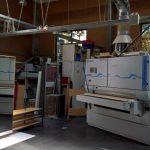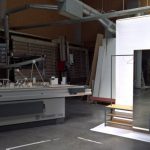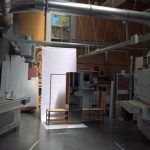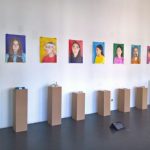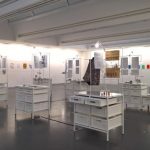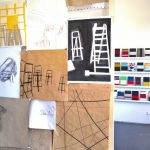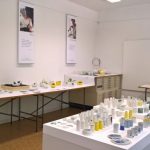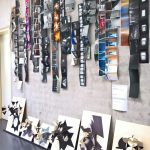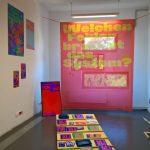#campustour 2018: Jahresausstellung, Kunsthochschule Burg Giebichenstein, Halle, Germany
“Welcher Fehler braucht ein system?”, “Which errors/mistakes/imperfections does a system require?”, asked the Kunsthochschule Burg Giebichenstein Halle’s 2018 annual exhibition.
And used the question as a celebration of the power of trial and error, of the value, importance, poetry, of imperfections, abrasion, the incorrect, the unintended, the random, the well planned but ultimately unsuccessful, and how any otherwise well-organised, professional and targeted system needs a nuisance factor, needs a source of imperfection, chaos, resistance, experimentation, an aberration, to keep it fresh, exciting, relevant and vital.
Thanks guys, appreciate it…….
Jahresausstellung 2018, Kunsthochschule Burg Giebichenstein, Halle
Tradition demands that we begin any post from the Kunsthochschule Burg Giebichenstein Halle by stating that it is/was four years older than its more illustrious near neighbour, Bauhaus; yet has always, arguably unjustly, languished in the shadow of the Gropius’ school.
For more on the history of Burg Halle we refer you dear reader to our 2017 #campustour post, but also our post from the exhibition Moderne in der Werkstatt – 100 Years Burg Giebichenstein Kunsthochschule Halle at the Kunstmuseum Moritzburg. Halle, unlike Weimar, having already celebrated its centenary.
The 2018 Burgh Halle Jahresausstellung offered the familiar mix of semester and graduation projects from across the schools programmes, whereby our principle focus was unapologetically design.
Amongst the semester projects presented Metamorphosen, for example, challenged students to reconsider Max Bill’s Ulmer Hocker; kunst.stoffe saw students developed an object to be produced from injection moulded recycled plastic; while the foundation course Gropius meets Madonna asked the students to develop an object or spatial concept based on a fusion of two opposing artistic/creative characters, and which produced pairings such as Alvar Aalto/Jean Michel Basquiat, Richard Sapper/Rachel Whiteread or mischer’traxler/Helene Fischer. The last pairing causing us to laugh so hard we choked. Though sadly we can’t remember whose twisted minds (so poetically) imagined such.
Amongst the graduation projects, to be honest, none spoke to us particularly, which is fine, the raison d’etre of graduation projects isn’t to interest us, imagine how frustrating and impossible the world would be if it was! However, and as previously noted one of the joys of the Burg Halle graduation projects presentation is that a room is set aside with all the theses, thereby allowing visitors to reflect in peace and at their own pace on the various works, for, and as ever, what is in those pages is, arguably, more important than the objects presented next door.
Elsewhere……
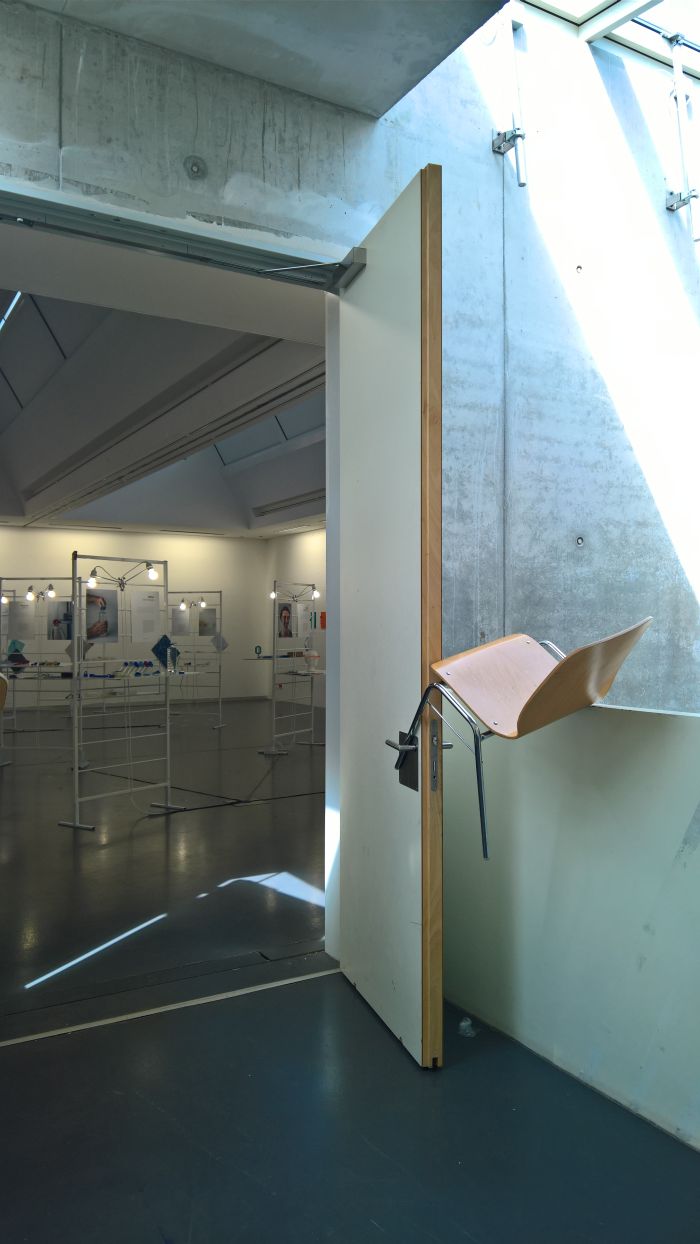
The chair-cum-doorstop on the 3rd floor…..For as long as we can remember it has been our principle reason for visiting the Burg Halle Jahresausstellung
Die absurde Maschine
Staged in context of the foundation class “Material.Form.Objekt”, Die absurde Maschine asked students to construct a machine that fulfilled a process associated with breakfast; the result being an improbable mix of Heath Robinson-esque wire and junk contraptions which performed tasks as varied as peeling a banana, slicing strawberries, or, and a particular favourite of ours, a device that with the combined efforts of just four people allows for the folding of a crêpe. Imagine!!
Pleasing and entertaining as the students response to the brief were, we didn’t consider any of the proposals in the least absurd. But then given some of the wholly improbable, impractical, illogical and thoroughly unwelcome digital projects we’ve experienced thus far on our #campustour, those expressions of an unfaltering belief in the supremacy of technology, in the principle that we must allow machines to do everything for us if society is to survive: a contraption that complicates folding a crêpe simply by way of proving that through the application of technology one can, is thoroughly normal. We expect there will be an App via which to arrange brunch hook-ups before the year is out.
Precious Plastic x Burg
One of the most unavoidable presentations at Sectie C during Dutch Design Week 2017 was that by the platform Precious Plastic. Established in 2013 by Design Academy Eindhoven graduate Dave Hakkens, Precious Plastic aims to encourage the recycling of plastic waste through the creation of open source machines that, if you will, make recycling and reusing plastic easier and more logical than binning it. Based around a global network of supporters who contribute new tools, processes, ideas, etc, Precious Plastic allows for the lo-cost, lo-tech, local recycling of plastic waste, and thus while not an answer to our dependency on plastics does help in managing our plastic waste. At Sectie C 2017 Precious Plastic took over a large hall, filling it with machines, examples of objects created by the community, and immense amounts of plastic waste. We don’t know if that was the moment that the Make platform at Burg Halle decided to join the global network, but since February 2018 Burg has had a plastic recycling factory based on Precious Plastic machines: important not only in terms of encouraging a coming generation of designers to think more actively about the waste they produce in the course of their daily work, but also important as design schools should take leads in such, shouldn’t just be platforms for developing ideas but also for their realisation and communication to others.
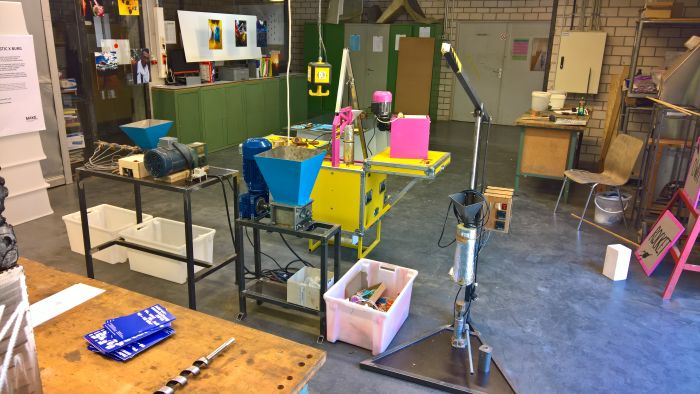
Precious Plastic x Burg plastic recycling facility, as seen at Jahresausstellung 2018, Kunsthochschule Burg Giebichenstein, Halle
Interspecies – Kommunikatiosnversuche
Under the guidance of guest Professors Amelie Hinrichsen and Till Bovermann the semester class Interspecies – Kommunikatiosnversuche [Interspecies – Communication Endeavours] asked the students to consider how raw sound could be used to enable the human species to communicate with non-human species, arguably to allow us to apologise, and to develop a translation machine for such.
Among the varied, and at times genuinely thought provoking results, Yan Ni developed with Ich möchte dich verstehen a methodology for communicating with plants; Endangered Buddies by Natalie Treutner, proposed a family of cuddly toys to help inform children about endangered species; while with Blind Faith Mathis Hosemann developed a computer programme which generates a new religion every minute based on an algorithm and which produced such joyful scriptures as “Money is extraordinary. I worship Kim Jong-un” Which is nice! Although…….
sowieso by Paula Schrott
Realised in context of the second year class, Hast du ein Problem, oder was?, a title featuring that overly aggressive tone one naturally associates with the Hallenser – JOKE!!! – the class asked students to identify a problem experienced by one of their friends/family, and which could be solved through an item of furniture. And then create that item of furniture.
We don’t know what problem Paula was aiming to solve, but do like her solution, sowieso*, as it were. Combining shoe storage with hanging space, a mirror and a low bench, sowieso offers everything one needs for the domestic lobby space in a pleasingly uncomplicated object.
A particularly nice touch is that the mirror slides, meaning the rails and shelves can be used in their full length, and why is the mirror component so deep? Because it also houses a small storage box for gloves, scarves, jute shopping bags, dog leads, et al…
Our main problem with sowieso is that it comes across as a little too dominant, lacks that degree of subtlety such an object needs to fit into a domestic space. Yes, we know its a second year semester project and isn’t intended to go on sale tomorrow, we know we weren’t at IMM: but still just feel it needs to be visually reduced. It may just be that the mirror element is too imposing, or that the bench is a tick too wide, the metal frame to sturdy, the wrong choice of materials in general…. Or that we’re wrong. Wouldn’t be the first time. Nor the last. However, as a proposal, very interesting and one we hope Paula gets an opportunity to further develop.
Full details on the Kunsthochschule Burg Giebichenstein Halle can be found at www.burg-halle.de
* sowieso is German for anyhow/anyway
- sowieso by Paula Schrott, as seen at Jahresausstellung 2018, Kunsthochschule Burg Giebichenstein, Halle
- sowieso by Paula Schrott, as seen at Jahresausstellung 2018, Kunsthochschule Burg Giebichenstein, Halle
- sowieso by Paula Schrott, as seen at Jahresausstellung 2018, Kunsthochschule Burg Giebichenstein, Halle
- #perfect by Marie Luise Möller & Paula Schinkel, as seen at Jahresausstellung 2018, Kunsthochschule Burg Giebichenstein, Halle
- Presentation of the class Reuse, as seen at Jahresausstellung 2018, Kunsthochschule Burg Giebichenstein, Halle
- Presentation of the foundation drawing and colour classes, as seen at Jahresausstellung 2018, Kunsthochschule Burg Giebichenstein, Halle
- Presentation of the class First steps in porcelain, as seen at Jahresausstellung 2018, Kunsthochschule Burg Giebichenstein, Halle
- Presentation of the classes Light Movement and Light & Shadow, as seen at Jahresausstellung 2018, Kunsthochschule Burg Giebichenstein, Halle
- Welcher Fehler braucht ein system?, as seen at Jahresausstellung 2018, Kunsthochschule Burg Giebichenstein, Halle
Tagged with: #campustour, Burg Giebichenstein, Halle

